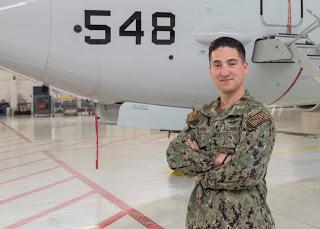
OAK HARBOR, Wash. – Petty Officer 2nd Class Colton Carr, a native of Clinton, Utah, joined the Navy due to a love of aviation and mechanics.
Now, seven years later, Carr serves as an aviation structural mechanic with the “Screaming Eagles" of Maritime Patrol and Reconnaissance Squadron 1, working with the Navy’s cutting-edge maritime patrol and reconnaissance aircraft at Naval Air Station Whidbey Island, Washington.
By Dustin Good, Navy Office of Community Outreach
OAK HARBOR, Wash. – Petty Officer 2nd Class Colton Carr, a native of Clinton, Utah, joined the Navy due to a love of aviation and mechanics.
Photo by Mass Communication Specialist 2nd Class Marc Cuenca
Now, seven years later, Carr serves as an aviation structural mechanic with the “Screaming Eagles" of Maritime Patrol and Reconnaissance Squadron 1, working with the Navy’s cutting-edge maritime patrol and reconnaissance aircraft at Naval Air Station Whidbey Island, Washington.
“The best part of this command is to visit so many different countries and have a lot more freedom then I would with other people,” said Carr.
Carr, a 2012 graduate of Northridge High School, with Maritime Patrol and Reconnaissance Squadron 1, a high-tech maritime patrol and reconnaissance squadron tasked with monitoring the world’s oceans in the state-of-the-art P-8A “Poseidon.”
“I am responsible for maintaining the body of the P-8 aircraft,” said Carr.
Carr credits success in the Navy to many of the lessons learned in Clinton.
“My parents always told me to always be honest and always push and do your best,” said Carr. "I realized if I was honest with myself and others I could get a lot done and accomplished."
Maritime Patrol and Reconnaissance Squadron 1's primary mission is to conduct maritime patrol and reconnaissance as well as long-range anti-submarine warfare, anti-surface warfare and intelligence gathering missions. They deploy around the world to monitor the world’s oceans wherever they are needed.
The P-8A Poseidon, the Navy’s newest maritime, patrol and reconnaissance aircraft, is a replacement aircraft for the legacy P-3C “Orion”. According to Navy officials, leveraging the experience and technology of the successful P-3C “Orion” with the needs of the fleet, the P-8A is designed to be combat-capable, and to improve an operator’s ability to efficiently conduct anti-submarine warfare; anti-surface warfare; and intelligence, surveillance, and reconnaissance missions.
As the Navy transitions to the full capacity with the P-8A “Poseidon”, the aircraft continues the work- horse tradition established by the P-3C “Orion”. The P-8A has a planned state-of-the-art open architecture mission system and next-generation sensors. These capabilities give warfighters added protection. The aircraft empowers the fleet with more combat capability, responsiveness, and interoperability with traditional manned forces and evolving unmanned sensors. The P-8A “Poseidon” has significant growth potential, with planned, phased-in technological improvements that extend global reach, payload capacity and higher-operating altitude.
“This is the third different type of Navy aircraft I've worked on,” said Carr. "The advancement in Navy technology is incredible."
Serving in the Navy means Carr is part of a world that is taking on new importance in America’s focus on rebuilding military readiness, strengthening alliances and reforming business practices in support of the National Defense Strategy.
A key element of the Navy the nation needs is tied to the fact that America is a maritime nation, and that the nation’s prosperity is tied to the ability to operate freely on the world’s oceans. More than 70 percent of the Earth’s surface is covered by water; 80 percent of the world’s population lives close to a coast; and 90 percent of all global trade by volume travels by sea.
“Our priorities center on people, capabilities and processes, and will be achieved by our focus on speed, value, results and partnerships,” said Secretary of the Navy Richard V. Spencer. “Readiness, lethality and modernization are the requirements driving these priorities.”
Though there are many ways for sailors to earn distinction in their command, community, and career, Carr is most proud of learning leadership.
“Growing up I was shy and quiet and the Navy has given me the opportunity to learn how to develop as a leader,” said Carr.
As a member of one of the U.S. Navy’s most relied upon assets, Carr and other sailors know they are part of a legacy that will last beyond their lifetimes contributing to the Navy the nation needs.
“The Navy gives me the opportunity to do a job that I like,” said Carr. "I get to experience so many cultures and go all over the world."